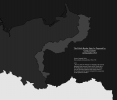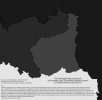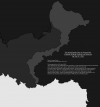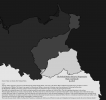I know that when the Mormons were preparing their trek westward Brigham Young considered settling both in Texas, Canada and I think California before finally deciding on the Great Basin. It is interesting that Texan government actually was interested in having them settle in the area.There's a line in the source doc that talks about a mormon autonomous region.
"Texas was underfunded, underpopulated, and still at war with Mexico. Therefore, a Mormon settlement in the disputed and remotely settled Nueces Strip would serve as a powerful buffer between Texas and Mexico. The Mormons possessed potential military strength, especially compared to Texas: the Nauvoo Legion in 1844 was four times the size of the Texan army at the Battle of San Jacinto in 1837. Importantly, even if – as Houston privately hoped – Texas were soon annexed to the United States, both the Texans and the Mormons would still have found a Mormon settlement useful: Texas still would have had additional frontier protection, while the Mormons would be far from the growing disorder of Nauvoo and American population centers more generally, and presumably their presence in Texas would be welcomed by its inhabitants. Thus, as both Houston and Woodworth perceived, a Mormon autonomous region on the Texas frontier could solve both Texas and Mormon political crises."
You are using an out of date browser. It may not display this or other websites correctly.
You should upgrade or use an alternative browser.
You should upgrade or use an alternative browser.
Proposals and War Aims That Didn't Happen Map Thread
- Thread starter Beedok
- Start date
I want to see the treaty in that world where they give up all of the Americas, the Philippines, and Australia in exchange for finally getting Gibraltar.
The only thing that really surprises me about that map is Australia.
Ditto!The only thing that really surprises me about that map is Australia.
This map thread and Totentanz0 have inspired me to make my own maps about proposed German/Austrian WW1 war goals. Half my maps are too big so I will just post the ones that are small enough.
If you want to see the whole maps with all the details then refer to my Deviantart (https://www.deviantart.com/tatzelwurm1545)
I also made a thread if you want to talk about the maps or just want to see when I have uploaded a new one.
Hope you enjoy!
If you want to see the whole maps with all the details then refer to my Deviantart (https://www.deviantart.com/tatzelwurm1545)
I also made a thread if you want to talk about the maps or just want to see when I have uploaded a new one.
Proposed WW1 war aims/wargoals mapped out by me
Hello there Mapnerds, This thread is for the discussion of my maps and the underlying information/people it involves. Essentially what I do is I go into online archives and read WW1 proposals made by Germans and map them out for your enjoyment and information. The people I include range from...
www.alternatehistory.com
Hope you enjoy!
Attachments
-
 the_polish_border_strip_proposals__georg_cleinow_by_tatzelwurm1545_dgmmxxf.png220.5 KB · Views: 210
the_polish_border_strip_proposals__georg_cleinow_by_tatzelwurm1545_dgmmxxf.png220.5 KB · Views: 210 -
 the_polish_border_strip_proposals_dt_kurier_4_7_15_by_tatzelwurm1545_dgmsvs1.png384 KB · Views: 190
the_polish_border_strip_proposals_dt_kurier_4_7_15_by_tatzelwurm1545_dgmsvs1.png384 KB · Views: 190 -
 the_polish_border_strip_proposals__l__v__schwerin_by_tatzelwurm1545_dgo5gem.png368.2 KB · Views: 186
the_polish_border_strip_proposals__l__v__schwerin_by_tatzelwurm1545_dgo5gem.png368.2 KB · Views: 186 -
 the_polish_border_strip_proposals__hans_von_seeckt_by_tatzelwurm1545_dgpbadf.png405.6 KB · Views: 207
the_polish_border_strip_proposals__hans_von_seeckt_by_tatzelwurm1545_dgpbadf.png405.6 KB · Views: 207
@Tatzelwurm1545 Here's some interesting proposals from earlier in this thread, hopefully you can dig for sources ⬇️This map thread and Totentanz0 have inspired me to make my own maps about proposed German/Austrian WW1 war goals. Half my maps are too big so I will just post the ones that are small enough.
If you want to see the whole maps with all the details then refer to my Deviantart (https://www.deviantart.com/tatzelwurm1545)
I also made a thread if you want to talk about the maps or just want to see when I have uploaded a new one.
Proposed WW1 war aims/wargoals mapped out by me
Hello there Mapnerds, This thread is for the discussion of my maps and the underlying information/people it involves. Essentially what I do is I go into online archives and read WW1 proposals made by Germans and map them out for your enjoyment and information. The people I include range from...www.alternatehistory.com
Hope you enjoy!
Unfortunately could not find a map, but the delusions of grandeur some German provincial monarchs had were....wild.
The King of Saxony, Frederick August, reportedly hoped to establish a personal union with the Baltic states, and Lithuania. He also of course had claims over Poland, but believed the Poles not to be worth it (apparently they were “too Jewish” and “anti-German”.)
The King of Wurttemberg, Wilhelm II, nothing to do with the Emperor, supposedly pressed claims on Belgium and hoped to incorporate it into his kingdom. Frederick August of Oldenburg wanted to divide France up into a northern republican government and a southern Bourbon kingdom.
Ludwig III of Bavaria wanted Alsace and claimed Antwerp in an attempt to gain access to the sea.
I know about all of them apart from Württemberg (but I think he means the Bavarian king wanting Belgium instead as that is a thing I can confirm and the Württembergian king doenst sound like the guy to do it). The issue is that I mostly only use original texts and I cant really reach them as they are not digitalized for some reason.@Tatzelwurm1545 Here's some interesting proposals from earlier in this thread, hopefully you can dig for sources ⬇️
- I have found the Saxon wargoals in the Saxony state archive, but they are digital and I am unsure how to get to them as I am just a hobbyist and not a historian.
- I have not yet looked for Württembergian wargoals tbh so I could try that.
- Bavarian wargoals are kind of weird as I see them everywhere but I have yet to find any sources I can actually access (The king had some insane ambitions btw, literally wanting Belgium, all of Alsace-Lorraine and maybe even a Corridor connecting the 2). I know that crown Prince Rupprecht made a memorandum in Spring 1915 about what he wanted, but once again, I have yet to find a copy I can access. Rupprecht's is especially interesting to me because of what is said in Fritz Fischer's book:
"the most ambitious expression of which is to be found in the Crown Prince Rupprecht's exposd of the spring of 1915. This is in answer to a memorandum by von Bissing, the Governor-General ofBelgium, on the Belgian question. Von Bissing's proposals were very much in the line of Bethmann Hollweg's own ideas: they envisaged an association of Belgium with Germany which should be economic and military rather than explicitly con stitutional. Rupprecht went further, in respect both of territorial and of constitutional changes. Holland, enlarged by the Flemish areas of Belgium and northern France, and Luxemburg, enlarged by the south-eastern portion of the Belgian province of the same name, were to enter the Reich as new federal states. Prussia would receive the other areas of northern France, Walloon Belgium with Li6ge and Namur, and the salient of Holland round Maastricht, while the rest of Lorraine (Longwy-Briey), with Alsace, was to be partitioned. This exposd is one ofa series ofendeavours by Bavaria to encourage Prussia's renunciation of her aspirations in Alsace. Rupprecht was expressly aiming at breaking Prussia's hegemony in the Reich by substituting for it a sort of trialist structure resting on Prussia, Bavaria and Holland. Although Rupprecht himself doubted as early as the end of r9r5 the possibility of a German peace of victory, Bavaria's war aims policy in respect of Alsace and her policy of 'combinations', either with Belgium (possibly through a separate peace in the east) or with Courland-Lithuania as Prussian acquisitions or spheres of interest,l continued in being throughout the war, as did Baden's and Wiirt temberg's (for Alsace, Mdmpelgard and Hohenzollern)2 and Saxony's (in the east), and constituted a f;rctor in favour ofannexa tions in the formulation of Germany's war aims policy." (sorry for the fucked transfer of text)
- Yes, the Oldenburgian is real and I love how ridiculous it is. However, I have yet to find his offical declaration, if he ever made one.
So yeah, archive's lack of digitalisation are what is currently holding me back.
Ok so, good news: I found parts of Rupprecht's memorandum.I know about all of them apart from Württemberg (but I think he means the Bavarian king wanting Belgium instead as that is a thing I can confirm and the Württembergian king doenst sound like the guy to do it). The issue is that I mostly only use original texts and I cant really reach them as they are not digitalized for some reason.
- I have found the Saxon wargoals in the Saxony state archive, but they are digital and I am unsure how to get to them as I am just a hobbyist and not a historian.
- I have not yet looked for Württembergian wargoals tbh so I could try that.
- Bavarian wargoals are kind of weird as I see them everywhere but I have yet to find any sources I can actually access (The king had some insane ambitions btw, literally wanting Belgium, all of Alsace-Lorraine and maybe even a Corridor connecting the 2). I know that crown Prince Rupprecht made a memorandum in Spring 1915 about what he wanted, but once again, I have yet to find a copy I can access. Rupprecht's is especially interesting to me because of what is said in Fritz Fischer's book:
"the most ambitious expression of which is to be found in the Crown Prince Rupprecht's exposd of the spring of 1915. This is in answer to a memorandum by von Bissing, the Governor-General ofBelgium, on the Belgian question. Von Bissing's proposals were very much in the line of Bethmann Hollweg's own ideas: they envisaged an association of Belgium with Germany which should be economic and military rather than explicitly con stitutional. Rupprecht went further, in respect both of territorial and of constitutional changes. Holland, enlarged by the Flemish areas of Belgium and northern France, and Luxemburg, enlarged by the south-eastern portion of the Belgian province of the same name, were to enter the Reich as new federal states. Prussia would receive the other areas of northern France, Walloon Belgium with Li6ge and Namur, and the salient of Holland round Maastricht, while the rest of Lorraine (Longwy-Briey), with Alsace, was to be partitioned. This exposd is one ofa series ofendeavours by Bavaria to encourage Prussia's renunciation of her aspirations in Alsace. Rupprecht was expressly aiming at breaking Prussia's hegemony in the Reich by substituting for it a sort of trialist structure resting on Prussia, Bavaria and Holland. Although Rupprecht himself doubted as early as the end of r9r5 the possibility of a German peace of victory, Bavaria's war aims policy in respect of Alsace and her policy of 'combinations', either with Belgium (possibly through a separate peace in the east) or with Courland-Lithuania as Prussian acquisitions or spheres of interest,l continued in being throughout the war, as did Baden's and Wiirt temberg's (for Alsace, Mdmpelgard and Hohenzollern)2 and Saxony's (in the east), and constituted a f;rctor in favour ofannexa tions in the formulation of Germany's war aims policy." (sorry for the fucked transfer of text)
- Yes, the Oldenburgian is real and I love how ridiculous it is. However, I have yet to find his offical declaration, if he ever made one.
So yeah, archive's lack of digitalisation are what is currently holding me back.
This sudden surge in posts on WWI Ostpolitik/war aims is making me feel much more useful. Great maps by the way.
 I can also give you some reading material
I can also give you some reading material
I've got some more "border strip" proposals. Here's Max von Hoffman's (Chief of staff for the Eastern Front). This is from his Der Krieg der versäumten Gelegenheiten
Hoffmann's claims about this are backed up and have further details provided from other sources in Baumgart's Ostpolitik. The whole incident is pretty characteristic of the struggle between the civilian government and the military during the war.
This is my interpretation of the proposal drawn up very quickly. Quality is terrible since the original file was way to large to post, but the red lines are my interpretation of the proposal. You can see pretty clearly what Hoffmann is talking about using a topographic map in some areas, in others its more open to speculation. The last part in particular about Osowiec fortress on the Bobr being very speculative, so I put two variants. Thinking about it now he might even have just meant the fortress and crossing itself as an exclave, and not the territory surrounding it.
But here is the map I used. I also looked at this one. They both show the topography pretty well.
Interested to see a better made version/other people's interpretations of the proposal.

I'm noticing that at this resolution the lines I drew are kinda hard to see, sorry about that.
Kauffman's Elusive Alliance has some good and more up to date info on the "border strip" and overall German intentions in Poland. The German's point man in Poland, Governor-General von Beseler, had his own ideas on (limited) German annexations in Poland, generally focusing on the Narwa and Biebrza (Bobr) rivers. I don't want to just copy and paste his whole book though.
On an unrelated note, while doing research I found some very imaginative proposals by Zentrum's Matthias Erzeberger on how to solve the Roman Question. I'll try to post them later.
Archives have to be pretty selective about what they digitize, based on demand and budget. The subject of German war aims during WWI is pretty niche so digitizing them is not really a priority.The issue is that I mostly only use original texts and I cant really reach them as they are not digitalized for some reason.
I can and would be very eager to help with this, send me a DM!- I have found the Saxon wargoals in the Saxony state archive, but they are digital and I am unsure how to get to them as I am just a hobbyist and not a historian.
Most common one I've seen in literature is the annexation of Montbéliard, based on their house's historical possession of it. Oh also Albrecht II was proposed as regent of Poland in 1918.- I have not yet looked for Württembergian wargoals tbh so I could try that.
Don't take Fischer's words as gospel (especially when it comes to Bethman-Hollweg but that's another discussion). Having read Rupprecht's diary, he was for the most part quite a pessimist actually. These royals also tended to shift their opinions pretty drastically, depending on who had their ear at the time.what is said in Fritz Fischer's book:
I've got some more "border strip" proposals. Here's Max von Hoffman's (Chief of staff for the Eastern Front). This is from his Der Krieg der versäumten Gelegenheiten
What's really interesting about this is the he and foreign secretary von Kühlmann actually got the Kaiser to accept this proposal (around January 1918),and it's the only variant of the border strip I know of which was officially accepted. When Ludendorff found out about this he was furious and he and Hindenburg actually threatened to resign unless the Kaiser rescinded the decision and had Hoffmann and Kühlmann resign. Wilhelm did the former but not the latter.In my opinion, the new Polish frontier ought to be drawn in such a way that it should bring to the Empire the smallest possible number of Polish subjects and that there should be only a few unimportant corrections of the frontier. To the latter I reckoned a small strip of land near Berdzin and Thorn, so that in any subsequent war the enemy artillery would not be able to fire straight into the Upper Silesian coal mines or on to the chief railway station of Thorn. I also calculated on the heights of Mlawa for the better defence of the Soldau district, and lastly, the crossing of the Bobr, near Osovice, which had caused us so many headaches.
The increase in Polish inhabitants, which would amount to about 100,000, would have to be taken into the bargain. But beyond that not a man.
Hoffmann's claims about this are backed up and have further details provided from other sources in Baumgart's Ostpolitik. The whole incident is pretty characteristic of the struggle between the civilian government and the military during the war.
This is my interpretation of the proposal drawn up very quickly. Quality is terrible since the original file was way to large to post, but the red lines are my interpretation of the proposal. You can see pretty clearly what Hoffmann is talking about using a topographic map in some areas, in others its more open to speculation. The last part in particular about Osowiec fortress on the Bobr being very speculative, so I put two variants. Thinking about it now he might even have just meant the fortress and crossing itself as an exclave, and not the territory surrounding it.
But here is the map I used. I also looked at this one. They both show the topography pretty well.
Interested to see a better made version/other people's interpretations of the proposal.
I'm noticing that at this resolution the lines I drew are kinda hard to see, sorry about that.
Kauffman's Elusive Alliance has some good and more up to date info on the "border strip" and overall German intentions in Poland. The German's point man in Poland, Governor-General von Beseler, had his own ideas on (limited) German annexations in Poland, generally focusing on the Narwa and Biebrza (Bobr) rivers. I don't want to just copy and paste his whole book though.
On an unrelated note, while doing research I found some very imaginative proposals by Zentrum's Matthias Erzeberger on how to solve the Roman Question. I'll try to post them later.
Last edited:
I think this will be of interest to you:Interested to see a better made version/other people's interpretations of the proposal.
I recently made this map for another thread, but it actually fits perfectly in this thread as well. It is a proposal of modest border changes "to improve the defences of Thorn, Soldau, and the Upper Silesian coal mines." This after a German victory against Russia in WW1. Source

This map thread and Totentanz0 have inspired me to make my own maps about proposed German/Austrian WW1 war goals.
Interested to see a better made version/other people's interpretations of the proposal.
I originally created that map of Hoffmann's proposal for this thread: What were German plans for poland if they won WW1
Might also be interesting to read.
Many of us have heard of filibusters -- mercenary-adventurers (usually Americans) who engage in unauthorised military expeditions, driven largely by personal ambition. The most famous American filibuster was William Walker, who invaded Mexico and successfully conquered Nicaragua without the backing of any government -- just his army of fortune-seeking rabble-rousers. (Of course, Americans weren't the only people to undertake this sort of adventurism -- for example, the French Comte de Raousset-Boulbon also invaded the Mexican state of Sonora in the 1850s, almost at the same time as Walker -- but as far as I know, the word "filibuster" generally applies only to Americans).
Now, most filibustering took place in the Western Hemisphere, in what 19th century Americans often considered their sphere of influence.
Here's a similar case of would-be filibustering -- although this one is out-of-time instead of out-of-place.
Operation Red Dog (also called the "Bayou of Pigs") was a 1981 attempt by neo-Nazis and Klansmen from the US and Canada to overthrow the government of Dominica, a Caribbean island nation (not to be confused with the Dominican Republic). They were stopped by the feds in Louisiana before they could depart.
Spanish colonial proposals in America:
It seems they also had some ambitions with their Equatorial Africa possessions, though I can't fully read that map:
Image source
Those were not coloniesSpanish colonial proposals in America:

Here's a similar case of would-be filibustering -- although this one is out-of-time instead of out-of-place.
Operation Red Dog (also called the "Bayou of Pigs") was a 1981 attempt by neo-Nazis and Klansmen from the US and Canada to overthrow the government of Dominica, a Caribbean island nation (not to be confused with the Dominican Republic). They were stopped by the feds in Louisiana before they could depart.
Also, very briefly -- there was an Islamist regime in the Caribbean.
On 27 July 1990, the Islamist group Jamaat al-Muslimeen attempted to overthrow the government of Trinidad & Tobago, occupying the parliament building for six days, and taking hostages which included the Prime Minister.
It should be noted that, although Jamaat al-Muslimeen was inspired by Islam, the stated motivations for the coup were things like austerity, widespread government corruption, and the influence of drug cartels. Prior to the coup attempt, the Jamaat al-Muslimeen had organised several vigilante campaigns against drug lords, seizing caches of cocaine and weapons and providing community defense where the corrupt police couldn't be relied upon. They also organised community services, providing food, shelter, healthcare, and other necessary services in the wake of austerity and a cost-of-living crisis. All this is to say that the Jamaat al-Muslimeen had popular support beyond just the Muslim minority in Trinidad & Tobago.
I don't know if/how the Jamaat al-Muslimeen could have formed a government. Although they were inspired by Islam, they didn't really want to establish a state ruled by Islamic law; just (allegedly) purge the influence of drug cartels and corrupt politicians. Whether or not they were sincere, it's probably a more reasonable justification for their regime, so far from the Islamic heartland.
Territorial demands of Serbia at the congresses of San Stefano and Berlin, in the aftermath of the Russo-Turkish War of 1877.

Did you make this because I am in awe of its beauty c:Territorial demands of Serbia at the congresses of San Stefano and Berlin, in the aftermath of the Russo-Turkish War of 1877.View attachment 893571
The author's account is in the top right.Did you make this because I am in awe of its beauty c:
Share: